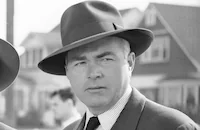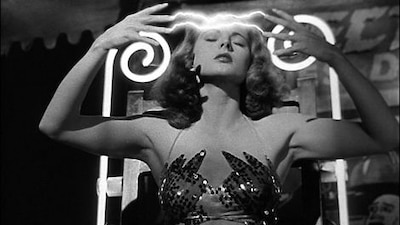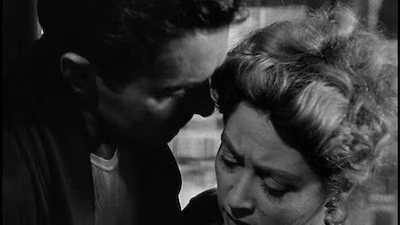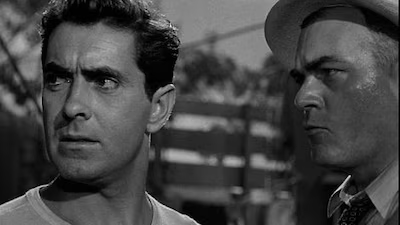Nightmare Alley

Brief Synopsis
Cast & Crew
Edmund Goulding
Tyrone Power
Joan Blondell
Coleen Gray
Helen Walker
Taylor Holmes
Film Details
Technical Specs

Synopsis
Stan Carlisle, an amoral carnival roustabout, exhibits a morbid fascination with the geek, a sideshow drunk who bites off the heads of live chickens in exchange for a daily bottle of liqour. Stan works with Zeena, a phony psychic who performs a mind reading act with her drunken husband Pete. Becoming intrigued when Molly, the naïve young assistant to Bruno the Strongman, tells him that Zeena and Pete were once vaudeville headliners who developed an elaborate word code worth its weight in gold, the handsome, highly manipulative Stan suggests that Zeena teach him the code so that they can work together. Zeena, who blames herself for her husband's dissipation, rejects Stan's proposal until he shrewdly suggests that their new act could fund the cost of Pete's cure. When Zeena consults her tarot cards for direction, however, they portend Pete's death, and alarmed, Zeena balks at making Stan her partner. Later that night, Stan buys a quart of liquor from the local moonshiner and stashes it in Zeena's trunk. When he encounters Pete shaking from alcohol withdrawal, Stan hands him the bottle, even though he knows that Zeena is determined to wean her husband from his addiction. The next morning, Pete is found dead from an overdose of wood alcohol and Stan realizes that he gave him the deadly drink by mistake. Weeks later, Stan has absorbed the code from the lonely Zeena, surpassing the abilities of his teacher. When a marshal comes to close down the carnival and arrest the troupe, Stan uses his charisma to play off the gullible lawman's fears, convincing him to drop the charges. After the marshal departs, an exhilarated Stan embraces Molly. When Molly protests that they are betraying Zeena, Stan claims his only interest in Zeena was in acquiring her code and then seduces the trusting girl. The rest of the carnival troupe has gathered at a seedy café, and when Molly and Stan arrive together, Bruno and Zeena realize that she has been seduced by Stan. After Bruno's threats force Stan into marrying Molly, Stan decides to leave the carnival and launch a new act with his wife. Some time later, Stan, now known as "The Great Stanton," is performing to great acclaim at an exclusive Chicago hotel. While attending the show one night, psychologist Lilith Ritter, suspicious of Stan's tactics, tries to outwit him by submitting a trick question about the health of her mother. After Stan replies that her mother is deceased, Lilith, impressed, invites Stan to her office. When their interview is interrupted by the unexpected arrival of Mrs. Peabody, one of Lilith's socialite patients, Stan leaves and Lilith proceeds to secretly record Mrs. Peabody's darkest confidences. Sneaking back into the office, Stan discovers the recording session and suggests using the information to bilk Lilith's wealthy clients. After denouncing Stan's proposal, Lilith throws him out. Later, following a performance, Zeena and Bruno visit Stan and Molly, much to Stan's displeasure. Upon consulting her tarot cards, Zeena foretells disaster if Stan strays from his present course and Stan, who believes in the cards though he pretends not to, angrily orders them to leave. Afterward, Stan is getting a massage when a whiff of alcohol triggers unpleasant memories of Pete's death. Panicking, Stan contacts Lilith and pours out his feelings of guilt to her. Despite Zeena's warning, Stan determines to embark upon what he terms "the spook racket." When Mrs. Peabody comes to the show to ask if she will ever see her daughter again, Stan, drawing on information he heard on Lilith's recording, responds that her daughter is dead and after accurately describing the departed girl, is about to relay a message when he faints. Controversy follows in the wake of Stan's disclosure, and when Mrs. Peabody informs her late husband's closest friend, the prominent Ezra Grindle, that she intends to help Stan bring spiritual comfort to others, the skeptical Grindle sets up a meeting with Stan to expose him. Swayed by Stan's charms and the promise of easy money, Lilith teams with Stan to convince Grindle of Stan's authenticity by feeding Stan the information from her secret recordings. Impressed by Stan's acumen, which he cloaks in religiosity, Grindle gives him $150,000 in cash to build a tabernacle and promises to buy him a radio station if he can establish contact with Dorrie, Grindle's long-lost love. After handing Lilith the cash for safekeeping, Stan studies photographs of Dorrie, then asks Molly to impersonate the dead woman's spirit. Declaring the ruse to be against God's will, Molly threatens to leave Stan who proclaims his enduring love, thus convincing the gullible Molly to pose as Dorrie. One evening, in a secluded area of Grindle's estate, Stan produces a distant illusion of Dorrie. When, entranced, Grindle begs Dorrie's forgiveness, Molly, unable to bear his anguish, approaches the distraught man, thus revealing who she really is, and runs off. Furious, Grindle attacks Stan, and after knocking down the elderly man, Stan speeds away with Molly and drops her off at their hotel with instructions to meet him later at the train station. After Stan informs Lilith about the debacle, she returns the cash-laden envelope and Stan hails a cab for the train station. En route, Stan opens the envelope and finds that Lilith has stuffed it with 150 one dollar bills, thus duping him out of a fortune. After Stan returns to confront Lilith, she cunningly tries to convince him that he is mentally imbalanced and reminds him that she possesses a recording of his confession about his complicity in Pete's death. When Stan hears a police siren approaching in the distance, Lilith insists that he is hallucinating and offers to commit him. Realizing that he has finally met his match, Stan runs away to meet Molly. Upon arriving at the train station, a distraught Stan hands Molly their life savings, exhorts her to find her way back to the carnival, then kisses her as her train pulls away. As headlines trumpet his fall from grace, Stan holes up in a cheap hotel room and begins his descent into alcoholic oblivion. Reduced to telling fortunes to hoboes along the railroad tracks, one day Stan comes across a carnival and asks for a job as a palm reader. Instead, the carnival owner offers him a drink and the job of geek. As recognition slowly dawns on Stan, he smiles and replies he was "made for it." Later that night, word spreads that the newly hired geek has gone berserk. Alarmed, Molly, who uknown to Stan, works at the carnival, goes to investigate and to her horror, finds Stan raving in the carnival yard. Running to Stan, Molly assures him that she will look after him, and in his alcoholic haze, he gratefully embraces her.

Director

Edmund Goulding
Cast

Tyrone Power

Joan Blondell

Coleen Gray
Helen Walker

Taylor Holmes

Mike Mazurki

Ian Keith
Julia Dean

James Flavin

Roy Roberts

James Burke
Maurice Navarro
Leo Gray
Harry Hays Morgan
Albin Robeling

George Beranger
Marjorie Wood
Harry Cheshire
Edward Clark
Eddy Waller
Mike Lally
George Davis
Hollis Jewell
Nina Gilbert
Bill Free
Gilbert Wilson
Jerry Miley
June Bolyn
Gene Stutenroth
Charles Flickinger
Florence Auer
Al Herman
John Wald
George Chandler
Oliver Blake
Emmett Lynn
George Lloyd
Jack Raymond
Jellie Nellie B. Lane
Clem Erickson
Laura Treadwell
Henry Hall
Crew
Bonnie Cashin
Mink W. Deronda
John C. Eagan M.d.
Jules Furthman
Lee Garmes
Gaston Glass
Earle Hagen
Roger Heman
George Jessel
Charles Lemaire
Thomas Little
Barbara Mclean
Harry Mendoza
Cyril Mockridge
Ed Mundy
Lionel Newman
Ben Nye
Maurice De Packh
Stuart Reiss
Fred Sersen
J. Russell Spencer
E. Clayton Ward
Lyle Wheeler
James L. Wood
Darryl F. Zanuck

Videos
Movie Clip




Trailer
Hosted Intro
Film Details
Technical Specs

Articles
Nightmare Alley
The same could be said of the movie, in which Tyrone Power plays Stanton Carlisle, a small-time carnie who charms fake mind reader Zeena (Joan Blondell) into sharing the secret of one of her hugely successful acts-and that's after he commits a mistake that causes the death of her husband, the drunkard Pete (Ian Keith). After he's learned Zeena's secret formula, Stanton ditches her for the younger and more nubile Molly (Colleen Gray); the two polish up the mind-reading act and take it on the road, bringing it to a posh night spot in Chicago. But Stanton isn't content with the act's success. He teams with a scheming psychoanalyst, Dr. Lilith Ritter (Helen Walker), to figure out a way to bilk the city's richest society figures, launching a spiral of corrosive evil that can only double back on him.
Nightmare Alley wasn't a hit upon its release. Audiences may have blanched, given the rather sordid subject matter, and if the stuffy review that ran in the New York Times is any indication, critics may not have fully understood the film, either. The paper's anonymous reviewer dismissed the picture, writing, "If one can take any moral value out of 'Nightmare Alley' it would seem to be that a terrible retribution is the inevitable consequence for he who would mockingly attempt to play God. Otherwise, the experience would not be very rewarding for, despite some fine and intense acting by Mr. Power and others, this film traverses distasteful dramatic ground and only rarely does it achieve any substance as entertainment."
But in the years since, Nightmare Alley has come to be considered one of the gems of film noir, and for good reason. The picture was directed by Edmund Goulding, a Hollywood veteran whose talents seemed to lean more toward melodrama (Of Human Bondage, Dark Victory). But he keeps Nightmare Alley taut and tensile-the picture never flags or droops; its foreboding undercurrent is beautifully sustained, from the moment very early in the story when Power's Stanton expresses his curiosity about a sideshow geek, a man who tears the heads off chickens with his teeth in exchange for a daily ration of booze. It's a horrific job, and Goulding never shows us the man directly, though we hear him screaming, unhinged and undone. "How does a guy become a geek?" Stanton asks one of his carny pals, but it's as if he already knows the answer in his heart. He can't afford to look too deep, lest he get a shuddering glimpse of his own future.
Power is superb and unsettling here-his manicured, elegant, leading-man good looks counterbalance his character's ruthlessness and, later, his hollow-eyed despair. The movie was deeply important to him. He had bought the rights to Gresham's novel, and then had to persuade a reluctant Darryl Zanuck and 20th Century Fox to go ahead with the film. The picture wasn't made on the cheap, as so many noirs were: Shot by the great and extraordinarily versatile cinematographer Lee Garmes - the man responsible for the lurid Technicolor majesty of Duel in the Sun, the soft fairytale hues of Zoo in Budapest, and the lush exoticism of Morocco -- Nightmare Alley has a suitably sinister, gritty shimmer. It conjures elements of Henri Cartier-Bresson, and points toward the work Diane Arbus would do some 10 years later.
Although Power fought to preserve the integrity of the novel, Zanuck fought him on the movie's ending, believing Greshem's original vision would be too cynical for audiences to take. But even the movie's happy - or at least just reasonably hopeful - ending isn't enough to reverse all the creeping dread that comes before. Gresham, by all accounts, knew that dread firsthand. He struggled with alcoholism himself, turning to Freudian psychoanalysis for help but finding no relief. For a time, he sought solace in Christianity, studying the work of C.S. Lewis. (His wife, the poet Joy Davidman, ultimately left him for Lewis.) He dabbled in Zen Buddhism, Alcoholics Anonymous and Scientology. But his personal problems, coupled with the fact that he never wrote another book as successful as Nightmare Alley, clearly became too much to bear. He committed suicide in 1962.
Almost miraculously, especially considering Zanuck's skittishness, the screenplay for Nightmare Alley--by veteran writer Jules Furthman (The Big Sleep, To Have and To Have Not, Mutiny on the Bounty)--doesn't make the story's foreboding twists and turns easy for the audience. The movie is resolute in the bleakness of its vision. And for that reason, it stands as a bold example of a mainstream work that doesn't talk down to its audience, that trusts viewers to follow it down some very dark pathways. Despite that faux-cheerful ending. Nightmare Alley is a work of desolate beauty, a vision conjured from the troubled side of sleep.
By Stephanie Zacharek
SOURCES: IMDb The New York Times "'Nightmare Alley,' by William Lindsay Gresham, reviewed by Michael Dirda," The Washington Post, May 13, 2010 "Ripe for a Remake," by Cliff Doerkson, The Chicago Reader, August 12, 2010 Alain Silver, Elizabeth Ward, James Ursini, Robert Porfirio, Film Noir: The Encyclopedia, Overlook Duckworth, 2010

Nightmare Alley
Nightmare Alley on DVD
In the hunky leading man's best role, Power plays Stanton "Stan" Carlisle, a young buck just started with a traveling carnival as the movie opens. He's delivering the spiels for psychic Zeena (Joan Blondell), who's aided in the act by her unseen partner Pete (Ian Keith). Pete's drinking has made him unfit to work in front of an audience, and was the problem that kicked his and Zeena's headlining vaudeville act down to carnivals. Stan is jockeying to take his place, already discreetly replacing Pete in Zeena's bed and yearning to be trusted with the secret verbal code Zeena and Pete used during their earlier, more lucrative act. When Pete's drinking takes him out of the act entirely, Stan gets the prized code from Zeena and, coincidentally or not, he's soon moved on from her to shapely circus girl Molly (Coleen Gray of Kansas City Confidential and The Killing). It's Stan and Molly who take the act to Chicago nightclubs, where Stan is a huge hit and falls in with an ethically-challenged psychologist to the rich (Helen Walker), who becomes his partner in a scheme to bilk the wealthy through spiritualism.
Stan gets off on putting things over on people, whether it's getting the code from Zeena, bamboozling audiences or being a fake medium who lets high-society folks think they're communicating with the departed. One of the things that makes him so interesting is that he's not such a total heel that he's only into conniving people. For instance, he genuinely likes Zeena and she likes him, so it's not as if he befriended her only to get her code. And, despite the privileged information shrink Lilith is feeding him, Stan is not without some sort of unusual mental talent. In one of the best scenes, he cools off a local-yokel sheriff looking to close the carnival by giving him a "cold reading" that nearly reduces the lawman to tears. These mixed motives and complex circumstances allow Stan to delude himself about his moral shortcomings and rationalize his schemes. By the last half-hour, Stan is fleecing money from the rich to build a "tabernacle," and apparently believing his own spiel. His come-uppance arrives fast and hard, leading to the alcoholism that destroyed Pete and the desperation and loss of self-respect Stan saw in the lowly carnival geek during the movie's first scenes.
The notion of the sideshow as a sort of pressure-cooker microcosm of larger society makes Edmund Goulding's movie a rare, post-1935 cousin to many of the silent movies of Lon Chaney (like The Unknown) and of The Unknown director Tod Browning's post-Chaney Freaks. Movies have rarely explored the dark side of human nature as Chaney and Browning did, especially after the production code was tightened in 1934 (though, as in Browning's later movie, the sideshow community is portrayed as supportive of its own). But with its undercurrent of sex - voluptuous Blondell, fresh-faced Gray and more tightly-wrapped Walker are all lookers - its dog-eat-dog climate and its precipitous rise and fall, Nightmare Alley heightens reality to sometimes chilling effect.
Nightmare Alley is the latest in the Fox Film Noir DVD series to feature audio commentary by the able team of authors James Ursini and Alain Silver. These guys know their noir, and they touch upon such topics as the reason for the movie's scarcity after its original release (a legal scuffle between Twentieth Century-Fox and producer George Jessel - yes, the same George Jessel who was a frequent Merv Griffin Show guest back in the 1970s), Power's role as the driving force behind getting the movie made and the movie's relation to William Lindsay Gresham's novel. The commentators fill in many details, though I don't know why they think Power, who was certainly not as young as Stan is meant to be, was older than Blondell.
For more information about Nightmare Alley , visit Fox Home Entertainment. To order Nightmare Alley, go to TCM Shopping.
by Paul Sherman
Nightmare Alley on DVD
Quotes
Trivia
Notes
According to documents in the Twentieth Century-Fox Records of the Legal Department at the UCLA Arts-Special Collections Library, the studio purchased rights to William Lindsay Gresham's novel in late September 1946 for $50,000. Gresham was also hired as a consultant to screenwriter Jules Furthman, but he is not credited onscreen and the extent of his contribution to the released film has not been determined. An analysis of the various drafts and outlines of the script contained in the Twentieth Century-Fox Produced Scripts Collection, also at UCLA, discloses that in the original October 25, 1946 outline, "Molly" divorces "Stan" and marries "Bruno," "Lilith" weds "Grindle," and Stan is relegated to the geek pit. This ending closely resembles that of Gresham's novel, the difference being that in the novel, Molly has a child by her new husband. A November 1, 1946 outline ends with Stan dying.
In November 1946 and January 1947 story conferences, studio chief Darryl Zanuck criticized the outlines as "lacking a sympathetic character to root for." Zanuck insisted that Stan's character be given some good traits so that the audience could relate to him. To accomplish this, Zanuck suggested that Stan be deeply affected by Pete's death and also learn to love Molly, remaining faithful to her despite Lilith's attentions. In Gresham's novel, Stan and Lilith are sexually involved. The death of "Dorrie" in the novel was due to an abortion, a point not mentioned in the film. Materials contained in the MPAA/PCA files at the AMPAS Library reveal that the PCA made the studio tone down its treatment of "illicit sex and adultery."
Hollywood Reporter November 1946 news items reported that Mark Stevens and Anne Baxter were to star in the picture with William Keighley directing. Materials from the Produced Scripts Collection yield the following information about the production: In January 1947, Lloyd Bacon was scheduled to direct. Although Hollywood Reporter production charts place Paul E. Burns in the cast, his appearance in the released film has not been confirmed. In a February 1947 handwritten note, Zanuck suggested casting Celeste Holm as "Zeena," June Allyson as "Molly," and Marlene Dietrich, Luise Rainer or Constance Bennett as "Lilith." An April 1947 memo adds that Morton Stevens was tested for the part of "Hoadley" at Tyrone Power's request. Although the Film Daily and Daily Variety reviews credit Earl Hagen with orchestral arrangements, an October 1947 letter in the Scripts Collection notes that although Hagen was given the original credit, the screen credits were revised so that Maurice de Packh would receive sole credit.
Publicity materials contained in the AMPAS Library add that the carnival set covered ten acres on the studio's backlot. Fox records state that scenes were shot in Del March at the San Diego County Fair. To create an air of authenticity, 100 sideshow attactions were hired to perform in the background. Early drafts included two dwarf circus performers named "Major and Mrs. Mosquito" who were to be friends of Molly and Zeena. According to the Produced Scripts records, the studio negotiated with George and Olive Brasno, presumably to play those roles. When the studio deleted the parts and broke off negotiations, the lawyer for the Brasnos sued and was awarded $2,500. Modern sources add Clancy Cooper, George Matthews and Robert Karnes to the cast.

Miscellaneous Notes
Released in United States Fall October 9, 1947
Re-released in United States January 28, 2000
Released in United States 2011
Released in United States Fall October 9, 1947
Re-released in United States January 28, 2000 (Cinema Village; New York City)
Released in United States 2011 (Guest Artistic Director Selection)
Based on the book "Nightmare Alley" written by William Lindsay Gresham and published by Rinehart and Company in 1946.















